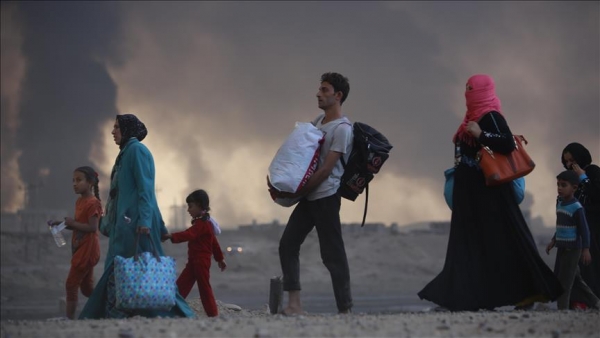Displacement of civilians is, deplorably, a common feature of all armed conflicts. From an international humanitarian law (IHL) perspective, however, it is extremely important to distinguish between the voluntary fleeing or relocation of persons, on the one hand, and the deportation or forcible transfer of civilians, on the other. The first is a regrettable, but unavoidable, occurrence of war, determined by the natural tendency of people to seek refuge away from the battlefield. The second can be defined as the coercive and unlawful uprooting of the inhabitants of a territory, which is, as such, generally prohibited under the law of armed conflict.
According to IHL, three main sets of rules are applicable, depending on whether deportation or forcible transfer of civilians takes place in a situation of occupation, in an international armed conflict (IAC) not involving occupation, or in a non-international armed conflict (NIAC). In the first case, the prohibition is set forth in Article 49(1) of the Fourth Geneva Convention (GCIV), which provides that “individual or mass forcible transfers, as well as deportation of protected persons from occupied territory to the territory of the Occupying Power or to that of any other country, occupied or not, are prohibited, regardless of their motive”. In situations of IACs, on the other hand, the protection accorded by IHL is defined by reference to the State of destination (art. 45 GCIV). Lastly, in NIACs, citation is made to Common Article 3 to the Four GCs and Article 17 of Additional Protocol II.
Deportation or transfer of civilians are included among the grave breaches of the Geneva Conventions, and they have also been defined as war crimes and crimes against humanity under international criminal law. In this respect, it is worth mentioning that deportation, as a crime against humanity, has been the subject of an unprecedented request filed by the International Criminal Court (ICC) Chief Prosecutor under Article 19(3) ICC Statute. In her motion of 9 April 2018, the Prosecutor, focusing on the cross-border nature of deportation, asked the Pre-Trial Chamber to rule on whether the Court has jurisdiction "over the alleged deportation of the Rohingya people from Myanmar to Bangladesh". The issue was of utmost importance, as it revolved around the fundamental question of whether the ICC may exercise territorial jurisdiction over actions committed by a non-State party to the Rome Statute - Myanmar - and carried over onto the territory of a State Party – Bangladesh. The Chamber’s response, delivered in September 2018, was affirmative. (To read more on the topic, please read the Report on the Independent International Fact-Finding Mission in Myanmar ).
As repeatedly stated by the International Criminal Tribunal for the Former Yugoslavia (ICTY), both deportation and forcible transfer refer to the involuntary and unlawful displacement of individuals from the territory in which they reside. However, while the two notions relate to the same reality for some people, others consider that transfer and deportation are two distinctive concepts with two autonomous meanings. In this regard, “deportation” presumes movement beyond State borders, whereas “forcible transfer” relates to relocation within national boundaries. For the purpose of the present article, we will adopt the definition used by the International Committee of the Red Cross (ICRC) and describe displacement as a process in which people are compelled to flee or to leave their homes or places of habitual residence in order to avoid the effects of armed conflict, including violence.
Displacement can have different roots, but not always constitute an indirect consequence of armed conflicts. Rather, it can represent a deliberate strategy of war, likely amounting to a violation of IHL. As explained by the ICRC, people’s experiences of displacement differ according to the circumstances that caused them to leave. When people flee as a consequence of war, for instance, they might be displaced for relatively short periods of time. Conversely, targeted IHL violations are more likely to trigger protracted displacement, and/or to make return a more remote option for the people affected.
Starting from this assessment, the ICRC has been examining the relationship between IHL violations and displacement, by observing and comparing concrete examples of current patterns in past and present-day conflicts. The outcome of this study yielded a 2019 Report, entitled Displacement in Times of Armed Conflicts, the aim of which is to draw attention to the key role that IHL plays in preventing and addressing this phenomenon, in particular violence, which itself is a cause of displacement. Thus, by setting a list of recommendations, the Report shows that a greater respect for IHL brings at least four benefits: it is one of several ways to address the causes of displacement and prevent people from becoming displaced in the first place; it plays a decisive role in enabling humanitarian action in support of people at risk of displacement; it contributes to ensuring that people are protected during displacement; and it contributes to creating an environment conducive to safe and dignified return.
Written by Federica Pira
For more information, please read:
https://www.icrc.org/en/document/ihl-displacement
Chetail, ‘The Transfer and Deportation of Civilians’, in A. Clapham, P. Gaeta, M. Sass.li (eds.)
Federica Pira, Deportation or Transfer of Civilians, in D. Djukic and N. Pons (eds.), “The Companion to International Humanitarian Law” (2018), Brill Publisher.




